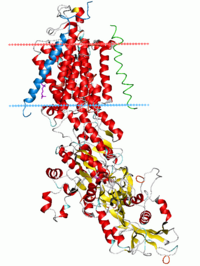
Microglia and astrocyte activation is region‐dependent in the α‐synuclein mouse model of Parkinson's disease
Sign Up to like & getrecommendations! Published in 2022 at "Glia"
DOI: 10.1002/glia.24295
Abstract: Inflammation is a common feature in neurodegenerative diseases that contributes to neuronal loss. Previously, we demonstrated that the basal inflammatory tone differed between brain regions and, consequently, the reaction generated to a pro‐inflammatory stimulus was… read more here.
Keywords: disease; model parkinson; parkinson disease; midbrain ... See more keywords

Neuroimmunomodulatory properties of DPSCs in an in vitro model of Parkinson's disease
Sign Up to like & getrecommendations! Published in 2017 at "IUBMB Life"
DOI: 10.1002/iub.1655
Abstract: In neurodegenerative diseases, such as Alzheimer's and Parkinson's, microglial cell activation is thought to contribute to their degeneration by producing neurotoxic compounds. While dental pulp stem cells (DPSCs) have been regarded as the next possible… read more here.
Keywords: properties dpscs; vitro model; parkinson; neuroimmunomodulatory properties ... See more keywords

Reassessment of subacute MPTP-treated mice as animal model of Parkinson's disease
Sign Up to like & getrecommendations! Published in 2017 at "Acta Pharmacologica Sinica"
DOI: 10.1038/aps.2017.49
Abstract: 1-Methyl-4-phenyl-1,2,3,6-tetrahydropyridine (MPTP) mouse model remains the most commonly used animal model of Parkinson's disease (PD). There are three MPTP-treatment schemes: acute, subacute and chronic. Considering the advantages of the period and similarity to PD, the… read more here.
Keywords: subacute mptp; mptp; animal model; model ... See more keywords

In vivo GluCEST MRI: Reproducibility, background contribution and source of glutamate changes in the MPTP model of Parkinson’s disease
Sign Up to like & getrecommendations! Published in 2018 at "Scientific Reports"
DOI: 10.1038/s41598-018-21035-3
Abstract: Glutamate Chemical Exchange Saturation Transfer (GluCEST) MRI is a recently developed technique to image glutamate. In the present study, we evaluated the reproducibility and background contamination to the GluCEST and source of the GluCEST changes… read more here.
Keywords: reproducibility background; contribution; model parkinson; model ... See more keywords

Involvement of adenosine triphosphate-sensitive potassium channels in the neuroprotective activity of hydrogen sulfide in the 6-hydroxydopamine-induced animal model of Parkinson’s disease
Sign Up to like & getrecommendations! Published in 2018 at "Behavioural Pharmacology"
DOI: 10.1097/fbp.0000000000000358
Abstract: Studies have shown that hydrogen sulfide (H2S) exerts a neuroprotective effect and may have a therapeutic value for treating neurodegenerative diseases including Parkinson's disease. However, little is known about the mechanisms underlying the neuroprotective activity… read more here.
Keywords: sensitive potassium; animal model; parkinson; parkinson disease ... See more keywords

Non-Reproducibility of Oral Rotenone as a Model for Parkinson’s Disease in Mice
Sign Up to like & getrecommendations! Published in 2022 at "International Journal of Molecular Sciences"
DOI: 10.3390/ijms232012658
Abstract: Oral rotenone has been proposed as a model for Parkinson’s disease (PD) in mice. To establish the model in our lab and study complex behavior we followed a published treatment regimen. C57BL/6 mice received 30… read more here.
Keywords: model parkinson; parkinson disease; disease mice; oral rotenone ... See more keywords

DL-3-n-butylphthalide alleviates motor disturbance by suppressing ferroptosis in a rat model of Parkinson’s disease
Sign Up to like & getrecommendations! Published in 2022 at "Neural Regeneration Research"
DOI: 10.4103/1673-5374.343892
Abstract: DL-3-n-butylphthalide (NBP)-a compound isolated from Apium graveolens seeds-is protective against brain ischemia via various mechanisms in humans and has been approved for treatment of acute ischemic stroke. NBP has shown recent potential as a treatment… read more here.
Keywords: model parkinson; parkinson; parkinson disease; rat model ... See more keywords